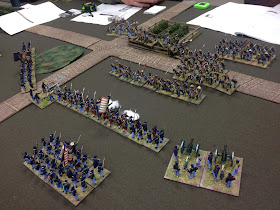 |
| General Kobold A contemporary portrait |
We set up a simple two-player game, with two of us on each side. The idea was to just get a feel for the mechanisms and see how they worked in practice - it's one of those games where it's not obvious from reading the rules how certain things will appear in actual play.
I can report that we were very impressed; we took our time over the game, but could see that with experience it would rattle along very nicely. I personally found the card management much easier to deal with than it is in 'Maurice' - it's a more fluid game, which is what you'd expect given the difference in the styles of warfare.
Basically we set up two equal forces on a simple, symmetrical terrain. Both sides had four regiments of infantry, each with eight stands, and two batteries of artillery, one with two bases and one with three. "longstreet Lite' doesn't cover different gun types, neither does it cover troop quality.
Ralph and I played the Union. Here's Ralph considering our deployment. I was confused at this stage, because 'Longstreet Lite' also doesn't include cavalry - what was I to do all evening?
The Rebels - Caesar and Bryan. Here they are checking whether their home state's constitution allows them to fire muskets on a Thursday.
The armies set up. The Union went for a long line with a reserve unit, whilst the Rebels concentrated for an attack on the Union right.
Union artillery.
Advancing rebels.
Lots of Confederates. Caesar appears to have discovered a loophole.
The game commences. We picked up the activation mechanism very quickly, and how to use modifiers and interrupts. Firing was fairly deadly, but the ability to negate casualties with cards seemed to easily offset this. But in the early stages of the game the number of hits being scored was low.
The Confederates advanced and prepared for an assault. Their spies claimed to have knowledge of the Union plans, but it wasn't correct (Caesar and Bryan played a card which allowed them to look at our hand, then remove two cards from it. They failed to remove the two cards we were planning to use to stymie their attack).
The Rebels close up for the assault. Our Zouaves were looking decidedly outnumbered.
Our master-plan! Just as the Confederates were about to launch their assault we played this, cutting down their commander and costing them most of their hand.
The attack went in, but without the modifiers the Confederates were hoping to apply. The odds were still in their favour, just through numbers, but we rolled well in the combat and forced a draw, which means that the attackers had to withdraw, with casualties. Unfortunately this meant that they had to withdraw through the units behind them. Normally they could burn cards to prevent disorder in this case, but with no cards left, due to our killing their general, this wasn't possible. So all four Rebel infantry units lost a stand during this turn.
We had the longer line, and used our movement to overlap the Confederate line and threaten their artillery battery on the right flank.
Their attack blunted the Confederates attempted to consolidate their position, whilst the Union cautiously advanced, muskets blazing.
By this stage the Union had lost all of their artillery, mostly to accurate counter-battery fire, but the Confederate position was looking decidedly shaky. We had a number of cards which increased the effectiveness of our firing, and we used them to great effect as we advanced, inflicting considerable casualties on the boys in butternut for very little return.
The Confederate artillery on their right limbered up and attempted to withdraw, only to stall at the last minute owing to an argument between two old rivals over the affections of a woman. Yes, another event card hampered the Rebel plan - their artillery failel to move, and was cut down by Union musketry.
We really enjoyed the game, and didn't seem to struggle with any of the mechanisms. It will be interesting to see what happens with more troops per deck (which will make it harder to ignore hits on units) and a denser terrain (which will make it harder to inflict hits in the first place). I suspect that at least a couple of club members will purchase the full rules when they are finally published. I'm keen to see how it works out for refighting actual battles, whilst I know that others are interested in the campaign mechanism.
Finally, your humble correspondent, in colour ...
(Game organisation by Caesar. Figures by Ralph and Bryan. Hat from Ralph. I just turned up)



















Thanks Alan for a great batrep! And for some master card play - all that Bridge you played at the Cavalry and Guards Club has payed off!
ReplyDeleteI actually learned to play bridge at school as part of my General Studies A-Level. True Fact :)
DeleteGreat contemporary portrait, you really look the part!
ReplyDeleteGreat AAR, I need to get my Union & Reb troops painted (along with all the other projects I have on the go!)
ReplyDeleteVery enjoyable, Alan!
ReplyDeleteThe Union forever! Hurrah, boys, hurrah!
ReplyDeleteNice looking game, and I like your portrait. As I mentioned on Sparker's blog I think Bryan should get some extra points or cards for having a beard Longstreet himself would envy.
ReplyDeleteIndeed he should :)
DeleteI went more for the Sherman look :)